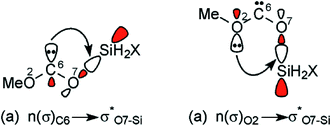Substituent effects and the role of negative hyperconjugation in siloxycarbene rearrangements†
Abstract
Substituent effects and the role of negative hyperconjugation in 1,2-silyl migration and

* Corresponding authors
a
Centre for Research in Molecular Modeling and Department of Chemistry and Biochemistry, Concordia University, 7141 Sherbrooke Street West, Montréal, Québec, Canada
E-mail:
ghp@alcor.concordia.ca
Fax: +1 (514) 848-2868
Tel: +1 (514) 848-2424 ext. 3335
Substituent effects and the role of negative hyperconjugation in 1,2-silyl migration and

 Please wait while we load your content...
Something went wrong. Try again?
Please wait while we load your content...
Something went wrong. Try again?
P. G. Loncke and G. H. Peslherbe, Org. Biomol. Chem., 2005, 3, 2191 DOI: 10.1039/B416058D
To request permission to reproduce material from this article, please go to the Copyright Clearance Center request page.
If you are an author contributing to an RSC publication, you do not need to request permission provided correct acknowledgement is given.
If you are the author of this article, you do not need to request permission to reproduce figures and diagrams provided correct acknowledgement is given. If you want to reproduce the whole article in a third-party publication (excluding your thesis/dissertation for which permission is not required) please go to the Copyright Clearance Center request page.
Read more about how to correctly acknowledge RSC content.
 Fetching data from CrossRef.
Fetching data from CrossRef.
This may take some time to load.
Loading related content
